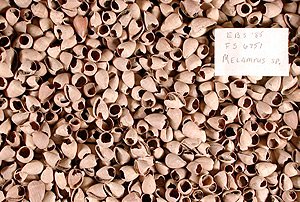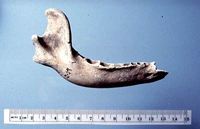Caribbean Faunal Exploitation

Ongoing excavations at various sites throughout the Caribbean are discovering growing evidence for overexploitation of resources, particularly fish and shellfish. This evidence includes a decrease in the sizes of territorial reef fishes, a decline in the relative abundance of predatory fishes high in the food chain (e.g. grouper and snapper), and a relative increase in the abundance of herbivorous fishes such as parrotfishes and surgeonfishes. Similar changes have been observed in reef fish populations that are intensively fished today. In the face of declining reef fish populations in addition to decreases in the sizes of some marine snails and land crab populations, it appears these early island inhabitants did not intensify the use of captive and domestic animals for food. Rather, people turned to other fishery resources, such as the tuna.
 Data revealing evidence of over-exploitation of marine resources comes from a number of diverse archaeological projects, including: the ABC islands off the coast of Venezuela; the Lesser Antilles including Grenada, Barbados, St. Kitts, Nevis, Antigua, St. Eustatius, St. Martin, and Saba; the Greater Antilles including Puerto Rico, Hispaniola, and Jamaica; the Virgin Islands; and the Bahamas including the Turks and Caicos, Samana Cay, Crooked Island, and San Salvador.
Data revealing evidence of over-exploitation of marine resources comes from a number of diverse archaeological projects, including: the ABC islands off the coast of Venezuela; the Lesser Antilles including Grenada, Barbados, St. Kitts, Nevis, Antigua, St. Eustatius, St. Martin, and Saba; the Greater Antilles including Puerto Rico, Hispaniola, and Jamaica; the Virgin Islands; and the Bahamas including the Turks and Caicos, Samana Cay, Crooked Island, and San Salvador.
References
Wing, Elizabeth S. (2001) Native American use of animals in the Caribbean. Pp. 481-518 in C.A. Wood and F.E. Sergile, eds. Biogeography of the West Indies: Patterns and Perspectives. Boca Raton, Florida: CRC Press.
Wing, Elizabeth S. (2001) The sustainability of resources used by Native Americans on four Caribbean islands. International Journal of Osteoarchaeology 11(1-2): 112-126.
Wing, Elizabeth S. and S.R. Wing (2001) Prehistoric fisheries in the Caribbean. Coral Reefs 20(1): 1-8.